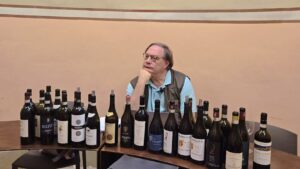So much has been written about Saxum Vineyards, a standout winery in California’s Paso Robles region, that one might wonder: what more can be added to the conversation? What fuels the persistent hype surrounding this producer? The answer lies in the glass—Saxum wines are good, really good. Yet, misconceptions persist. I’ve often encountered the question, “Aren’t those wines huge?” To which I respond, “When was the last time you tasted them?” The reply is frequently, “Oh, I had a bottle many years ago.” That’s telling. Judging the tireless efforts of a winery based on a distant memory is hardly fair. Today’s Saxum wines deserve a fresh look, and they reward those who approach them with an open mind.
Structure, Balance, and Evolution
Saxum’s wines are undeniably structured, boasting significant dry extract—a technical measure of the solid material left after evaporation, which contributes to texture and concentration. But to dismiss them as “behemoths” misses the mark. These are not overdone or manipulated wines; rather, they are authentic expressions of their terroir and a style that has come to define Paso Robles in profound ways. Decades ago, the winery’s offerings may have leaned bigger—reflecting a broader trend in California winemaking where producers competed to craft the “bigger, blacker” wine. Even then, Saxum stood apart, achieving balance amidst the bombast. Today, under the stewardship of founder Justin Smith, his son Colin, and a skilled team, the balance that has always defined Saxum’s wines—evident even in the more robust styles of past decades—has reached new heights: wines of finesse, layered with deep, complex, savory notes that linger, showcasing a sophistication that sets them apart from the fuller bodied, fruit-driven trends of yesteryear.
This evolution is no accident. Saxum’s approach hinges on precision, from vineyard to bottle. The wines’ ability to age gracefully—where extended time in barrels enhances rather than diminishes their character—sets them apart from many California peers. I’ve often found that prolonged aging in barrel can penalize other wines from the state, flattening their vibrancy and dry out the fruit. Not so with Saxum. Justin attributes this to their aging environment: a cave maintaining a steady 55°F with no temperature fluctuations and a consistent, healthy level of humidity. This stability preserves the wines’ integrity, allowing their structure to soften and their complexity to unfurl over time. It’s a revelation that challenges assumptions about California grapes’ aging potential, shedding new light on what’s possible in Paso Robles.
The Craft Behind the Complexity
What makes Saxum wines so compelling? On the surface, the formula seems straightforward: exceptional farming, clean and precise winemaking, co-fermentation, and intuitive harvest timing. Yet, there’s an extra layer of complexity that defies easy explanation—a depth that hints at something more. Justin, a winemaker with a discerning palate honed not just by wine but by a genuine passion for food, isn’t divulging the full secret. His curiosity and adventurous spirit as an eater—a trait I’ve noticed among the world’s top winemakers—seem to inform his craft. This sensory intuition likely guides his decisions, from the vineyard to the blending table.
In the vineyard, Saxum’s sites—steep, limestone-rich hillsides in Paso Robles’ Willow Creek District—provide the raw material. These are challenging, low-yielding parcels that demand meticulous care. Adding to this foundation, Justin now owns an 11-acre farm in Cayucos, just 4.5 miles from the ocean. Planted entirely with own-rooted Estrella clone Syrah, this site sits at 1,600 feet on calcareous soil—a rarity this close to the coast. The cool, windy, and wetter climate here contrasts with Paso Robles’ warmer interior, promising wines of ultra-exciting potential: vibrant, structured, and distinct. The estate cultivates an impressive array of varieties, including Syrah, Grenache, and Mataro (Mourvèdre), alongside Petite Sirah, Graciano, Touriga Nacional, Counoise, Carignan, Grenache Blanc, Roussanne, Chenin Blanc, and Chardonnay. Each grape plays a distinct role, contributing to the wines’ harmony and nuance from the very start; these are not wines chasing trends or pandering to scores—they’re honest, distinctive, and, yes, amazing.
For those still clinging to outdated perceptions of Saxum as a producer of “huge” wines, it’s time to revisit. The hype is real, but it’s earned through hard work, evolution, and an unwavering commitment to quality. Open a bottle, let it breathe, and taste for yourself. The proof is in the glass.
A Snapshot of Paso Robles Vintages
2021 Vintage: ★★★★
The 2021 growing season in Paso Robles was a bit of a rollercoaster but landed on solid ground. After a dry winter, things kicked off with moderate temps and a steady spring—nothing too crazy. Hang time was decent, letting the grapes build flavor without rushing them, though a few heat blips in late summer had folks on edge. Most producers played it safe, picking a tad earlier to lock in freshness, and it paid off with wines showing bright fruit and solid acidity. Not every wine’s a knockout—some lack that extra phenolic depth you’d want in a dream year—but there’s a vibrancy here that’s hard to ignore.
2022 Vintage: ★★
A difficult year across much of California, 2022 was marked by persistent drought and an intense Labor Day weekend heatwave that tested viticultural and winemaking skill. In Paso Robles, extreme heat in early September forced many producers to harvest prematurely, often before full phenolic development could be achieved—critical for tannin structure, flavor complexity, and color in red wines. As a result, many wines from this vintage show lighter structure and lack the depth of stronger years, though some benefit from lifted aromatics and bright red fruit. Notably, Saxum’s Justin Smith adopted a high-risk, high-reward strategy: rather than pick early, he waited out the heat and manually trimmed desiccated clusters—sacrificing roughly 35% of his crop. He also co-fermented Grenache with Mataro (Mourvèdre), a more heat-resilient variety, to add structure and savory complexity. While 2022 remains challenging overall, wines from meticulous producers show admirable finesse.
2023 Vintage: ★★★★★
Widely regarded as one of the most promising vintages in recent memory, 2023 delivered near-ideal growing conditions in Paso Robles. Ample winter and spring rainfall replenished soil moisture, supporting vine health and uniform growth. A long, moderate growing season followed, with minimal heat extremes, allowing for extended hang time and even ripening across varieties. The early tastings are already displaying exceptional balance, aromatic complexity, and depth. If the trajectory holds, 2023 could rival or surpass the best vintages of the past two decades in Paso Robles.
2024 Vintage: ★★★★
After a wet winter and spring that helped recharge water tables, the 2024 vintage unfolded with four significant heat spikes during the growing season. Fortunately, these heat events were relatively short-lived, and the well-hydrated vines responded with resilience. Harvest occurred earlier than usual, but the grapes achieved full ripeness with modest sugar accumulation, resulting in wines with lower alcohol levels and impressive aromatic lift. Early barrel samples suggest a vintage marked by freshness, precision, and purity of fruit. While perhaps not as uniformly exceptional as 2023, the 2024 wines are shaping up to be elegant, balanced, and expressive.

The wines in this tasting report




